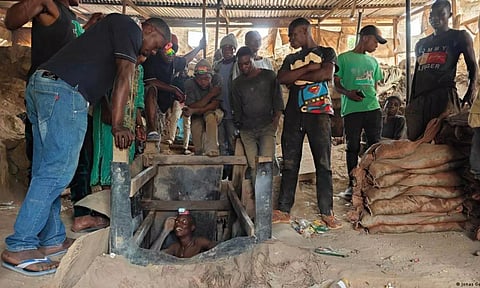

• JONAS GERDING
UNITED NATIONS: Mining engineer Pierre Amani Kangenda peers into the mouth of a narrow shaft that plunges straight down to the belly of a cobalt mine. He can’t quite make out the silhouettes of the young men whose job is to heave 20-kilogram sacks of dirt rich in cobalt and copper composite up the mine wall to the surface. But he can see their headlamps in the darkness. The men use pickaxes and shovels to dig for cobalt in this small-scale mine known as UCK Drain on the outskirts of Kolwezi in the DRC’s southern copper belt, where great amounts of cobalt are mined.
“As soon as they reach the vein of ore, they start extracting the raw materials,” says Kangenda who is decked out in a high-visibility vest as he conducts his daily patrol of the site which has 59 shafts.
“When they reach a depth of 30 meters (98 feet), they stop and look for another place to dig. That’s what the rules [on this site] say.”
Elsewhere, shafts can sink as deep as 100 meters, depending on local regulations. The Democratic Republic of the Congo accounts for some two-thirds of the world’s cobalt, dwarfing the output of its closest competitors, Australia and Russia. Around 15-20% of Congo’s cobalt supply is dug up by artisanal miners like those working here at UCK Drain.
Tunnelling deep into the red dirt is hard and dangerous work. However, it’s somewhat safer here than at other artisanal mines in the country. That’s because Kangenda, who works as a monitor and trainer for RCS Global, a consultancy with a focus on supply chain transparency and responsible sourcing, is there to make sure standards are being upheld.
“I check what problems there are. Are there children on site? Is there violence and rape?” he tells DW. The tunnels must be secured and closed down if cracks appear, Kangenda explains, and corrugated iron roofs over the shafts are erected to protect them from rain. Pregnant women and military personnel aren’t allowed on the site.
“If there are incidents, we report them to our partners. We try to correct them so that the supply chain is internationally acceptable,” Kangenda explains. Kangenda documents everything he observes on his patrols into a computer program. The mine is one of eight that are part of RCS’s Better Mining program, which aims to continuously monitor and support the improvement of conditions on and around artisanal and small-scale mine sites.
Partner companies along the supply chain can view the data logged in the program and react to it. This is important as the demand for cobalt continues to skyrocket.
Cobalt is a key component of rechargeable lithium-ion batteries that power electronic devices and electric vehicles (EVs). But reports of dangerous working conditions and child labor in Congo’s informal mines have sparked an outcry over what has been referred to as “blood cobalt” in recent years.
This is forcing EV manufacturers, who market themselves as sustainable, to look for ways to source ‘clean cobalt’ untainted by abusive labor practices. This is proving a difficult undertaking. Because of the monitoring of this mine, it’s relatively easy to ban children from working in the tunnels or even from entering the actual mining site. But it’s more difficult to stop children selling the raw ore they find by sifting through rock scraps on-site to the Chinese middlemen who control the majority of the trading depots. “We try to explain to the depot owners that they are not allowed to buy the raw materials brought to them by children,” says Kangenda.